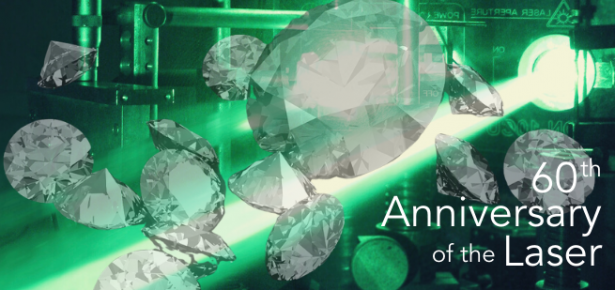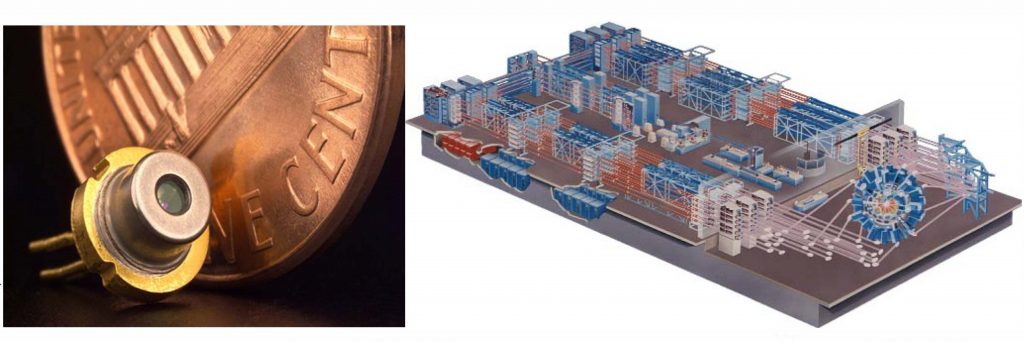
A rich literature is available on the discovery of Light Amplification by Stimulated Emission of Radiation and the construction of the first working (optical) ruby laser by Maiman. Personally, I very much appreciate the book The History of the Laser by Mario Bertolotti (IOP Publishing, Bristol, UK, 2005.), first edited in 1999. It presents a beautifully written time-line towards the final invention of the laser, comprising all physics developments, theoretical and experimental, that were essential for the first operation of this device on the 16th of May 1960. The book contains many illustrations to present the required material from various domains of physics, it uses just three small equations and presents a wealth of historical details. Another publication, Short history of laser development by Jeff Hecht (Opt. Eng., 49, 091002, 2010.), covers in a shorter framework the first 50 years of `laser action’. In Fig. 1 we show the impressive development, both in size and power, of the original optical laser device in 1960. In what follows I will discuss some personal experiences in applied physics research dealing with lasers as special light sources. I will also briefly sketch the vast field of laser-related research in physics (and chemistry) and give a short overview of the numerous laser applications in daily life.

As an undergraduate student, in 1966, I was given an experimental assignment to measure the Raman effect of nitrobenzene, using a classical mercury arc lamp as light source. To reveal the anti- Stokes lines, exposure times of the order of eight hours were needed overnight! In the master phase, a HeNe laser was my light source to interferometrically measure very small angular displacements, down to 5.10-8 radians. As a graduate student at the Institute of Optics in Paris, my research subject was the recording of holograms with the aid of spatially incoherent light. Here I got back to my cherished mercury arc lamp with forced cooling, making the interferometric hologram recording rather delicate. The spatial incoherence at the hologram recording was meant to study the influence of laser speckle. This subject was a hot topic in the early years of laser experimenting, first to quantify the statistics of speckle phenomena, secondly to eliminate its possibly negative influence on hologram reconstruction noise. Reducing the speckle noise of a laser with the aid of two diffusers in relative movement was a known principle. Another method that proved to be successful was the time-sequential scanning of the angle of incidence of a coherent laser beam on the object, within the total hologram exposure time (J. Braat and S. Lowenthal. Short-exposure spatially incoherent holography with a plane-wave illumination. J. Opt. Soc. Am. 63:388-390, 1973.).

My next rendezvous with laser sources was when I started working on optical disc systems at the Philips Electronics company. Initially, this company which also owned a large lighting department, had ambivalent feelings towards the laser source. As was often said in those days, following Maiman’s assistant Irnee d’Haenens, the laser was `a solution in search of a problem‘. For a consumer product company like Philips, it was clear that the typical street price of a HeNe laser (500 to 1000 US dollar) was prohibitive for it becoming a mass product. Optical, mechanical and electronic simplifications were needed to bring the HeNe laser to the mass-production phase. See, for instance, Fig. 2 with some fabrication-friendly mechanical innovations enabling automatic alignment of laser glass body, exit mirrors and cavity-length tuning unit. When the ideas about optical data storage came about, first for frequency-modulated analogue video signals, it was immediately clear that a classical source, even a high-pressure mercury lamp would fall short of the required source radiance for such a system with a typical signal bandwidth of 8 to 10 MHz. The read-out signal by means of a diffraction-limited scanning spot focused on the information track of the optical disc would severely suffer from the basic photon shot noise present in the detector signal. As a comparison, a 50 W high-pressure arc lamp produces a theoretical power of approximately 0.1 mW in a diffraction-limited focused spot, a 1 mW HeNe-laser is capable to virtually focus its entire power in such a tiny spot. Early optical data storage experiments quickly showed the inadequacy of `classical’ light sources for optical data storage. It took several years to bring the price of a classical HeNe laser down to a consumer-market level. In the Video Long Play and LaserVision players at the end of the 1970s and the beginning of the 1980s, some 50 to 100k HeNe lasers must have been incorporated in the optical playing units until a new laser source was able to prove its superior specifications for optical data storage: the AlGaAs semiconductor laser. Its main advantages were the small volume of the light source, the high wall-plug efficiency, its high peak power (up to a hundred mW) and, quite importantly, its intensity modulation possibility, up to frequencies of several hundred MHz. This latter property was essential for recording and/or rewriteable storage systems and for optical telecommunication networks. Various generations of this laser type have been produced, in output colour ranging from infrared (780 nm) via red (635 to 650 nm, AlGaInP) to violet (405 nm, GaN). The total number of produced semiconductor lasers (also present in the majority of telecommunication networks, In-GaAsP) must exceed several billions.
Let me now briefly summarise, in arbitrary order, the many other research fields and technical applications in which laser sources play an essential role because of one or several specific properties.
The many new applications and research fields created by the laser invention are further illustrated by the following list of Nobel Prize laureates in physics and chemistry:

Latest Comments
Have your say!